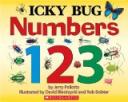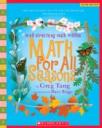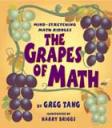Introduction:
The mathematical topic for this post is meant for second graders who are recalling addition facts to sums of 20 or less and the corresponding subtraction facts. The focus is number relationships and is based on VA SOL 2.5. The following books are resources that children can use in order to sharpen their addition and subtraction skills.
Recommended Books:

Icky Bug Numbers 123 written by Jerry Pallotta and illustrated by David Biedrzycki and Rob Bolster is a book that takes children from zero to ten and on each number, there is a corresponding number of bugs. On 0, there are no bugs. On numbers 1 through 10, each number has a different bug. For example, there is one ant on the 1; there are two butterflies on the 2; there are seven spiders on the 7, and so on up to number 10. What’s neat about the next section of the book is that Pallotta mixes the bugs on the numbers so children will understand the idea of sets. On the number 7, there are four spiders, one dragonfly, one lady bug and one moth. Despite the fact that there are four separate bugs, the total number of bugs is still seven. The book also contains skip counting odd and even numbers to twenty and simple addition equations where the child will add groups of bugs together. The end of the book concentrates on subtraction. There is a spider that is capturing flies in its web. Pallotta introduces simple subtraction equations in reference to the bugs the spider has cocooned or eaten. I think second grade boys will really like this book. The illustrations of the bugs are amazing, and some are pretty creepy. The book is perfect for addition facts to 20 and corresponding subtraction facts.

Math for All Seasons written by Greg Tang and illustrated by Harry Briggs is a book of 16 addition and subtraction riddles. Students can solve the riddles by counting objects or grouping objects on the page. The author encourages children to find quick ways to solve the riddles by grouping then adding or subtracting. The illustrations of objects such as, tulips, butterflies, umbrellas, dandelions, etc. are beautiful. Each riddle is a rhyme so the book could be considered cross-curricular as far as reading. Tang explains the best way to solve each riddle at the back of the book.

The Mission of Addition by Brian P. Cleary and illustrated by Brian Gable is a book about adding sums. “6 yellow buses were parked in a line, 3 pulled behind them, and then there were 9. Along came 4 more, and that made13. If you got that right, you are an adding machine!” All of the scenarios in this book engage students in adding a sum, then adding more to that sum to get a total. It breaks down addition equations into simple terms. Examples are: “numbers climb from low to high,” “add means to increase,” “plus can be used just like and,” and “equals can be used like is, or totals, or makes.” Children learn how to add numbers together rather than counting objects. The book is well illustrated and easy to read.

The Grapes of Math by Greg Tang and illustrated by Harry Briggs is a book of math riddles that encourages students to group like objects into sets, then add the sets together to forms sums or subtract groups in order to find the difference. Objects in this book are ants, strawberry seeds, camels humps, dice, etc., and the illustrations are wonderful. There are a total of 16 riddles in this book and answers are in the back. There are groups that total sums higher than 20 so it may be more a little complicated than the book Math for All Seasons by the same author. The riddles are in a rhyme format and Tang gives clues to help the students group objects as opposed to counting.
Math Appeal by Greg Tang and illustrated by Harry Briggs is another book that offers children great practice in addition and subtraction. Tang uses riddles to challenge children to see patterns in numbers. The patterns are located on beautifully illustrated objects such as, peas in pods, red hot chili peppers, clovers, geese, etc. Patterns can be determined by colors, shapes, or pure number of objects. Every riddle is a rhyme that challenges students to see the pattern, group the sets of objects, and then determine the sum or difference depending on what the riddle asks. Like his other books, each of the 16 riddles are different and the answers can be found in the back of the book. This book would be a great challenge for students who have mastered the VA SOL 2.5 because many of the sums and differences are above 20.
Recommended Websites:
Countdown and other games such as, Give Me Time and 20 Questions are excellent practice for students on need to brush up on their addition facts to 9+9. Simply scroll down to “Play” and choose any one of the three games. You can navigate from this page to practice subtraction facts and learn about inverse relationships of addition and subtraction.
The Timernator is a great site for addition and subtraction. Kids practice math against the clock. It helps them develop addition and subtraction skills without the pressure of being timed in a classroom environment.
Addition Game-fishing is a fun site where children get to catch the fish that equals the correct sum. There is also the Subtraction Game-fishing where children get to catch the fish that equals the correct difference.
Addition Concentration is a fun game that is played just like Concentration. You select an addition problem from the left set of squares and then try to find the correct answer from the set of squares on the right. A smiley face pops up when you get the correct answer.
Mathcar Racing is a site where children can practice addition or subtraction. The child will race against another car by determining the sum or difference that provides the highest total out of the the choices of math facts on the board.
Duck von Fly is a subtraction game that specifically focuses on subtraction facts between 1 and 20. The objective is to keep Duck von Fly up in the air by choosing the correct difference of a subtraction problem. The answers are multiple choice.
Additional Resources:
Two Dice Sums is an activity that can be played in the classroom or the home. It was a favorite activity developed by Marilyn Burns for the classroom.
Math word problems as well as several different lesson plans, activities and worksheets are listed on this site. The link is to the word problems page but there are links on this page that will navigate to other activities and worksheets. This would be a great site for teachers.
Super Teacher Worksheets is an excellent site for fun games and activities that teachers can print off for their students. This link takes you directly to the addition page. You can easily navigate from this page to other math topics such as subtraction.
Hotchalk is a site for lesson plans and activities for teachers. This link will send you to a list of plans and activities for addition and subtraction.
Math Fact Cafe is a website where teachers can build grade specific fact sheets or download pre-made grade specific fact sheets. It’s a good site for assessments and it also contains games for classroom activities.
